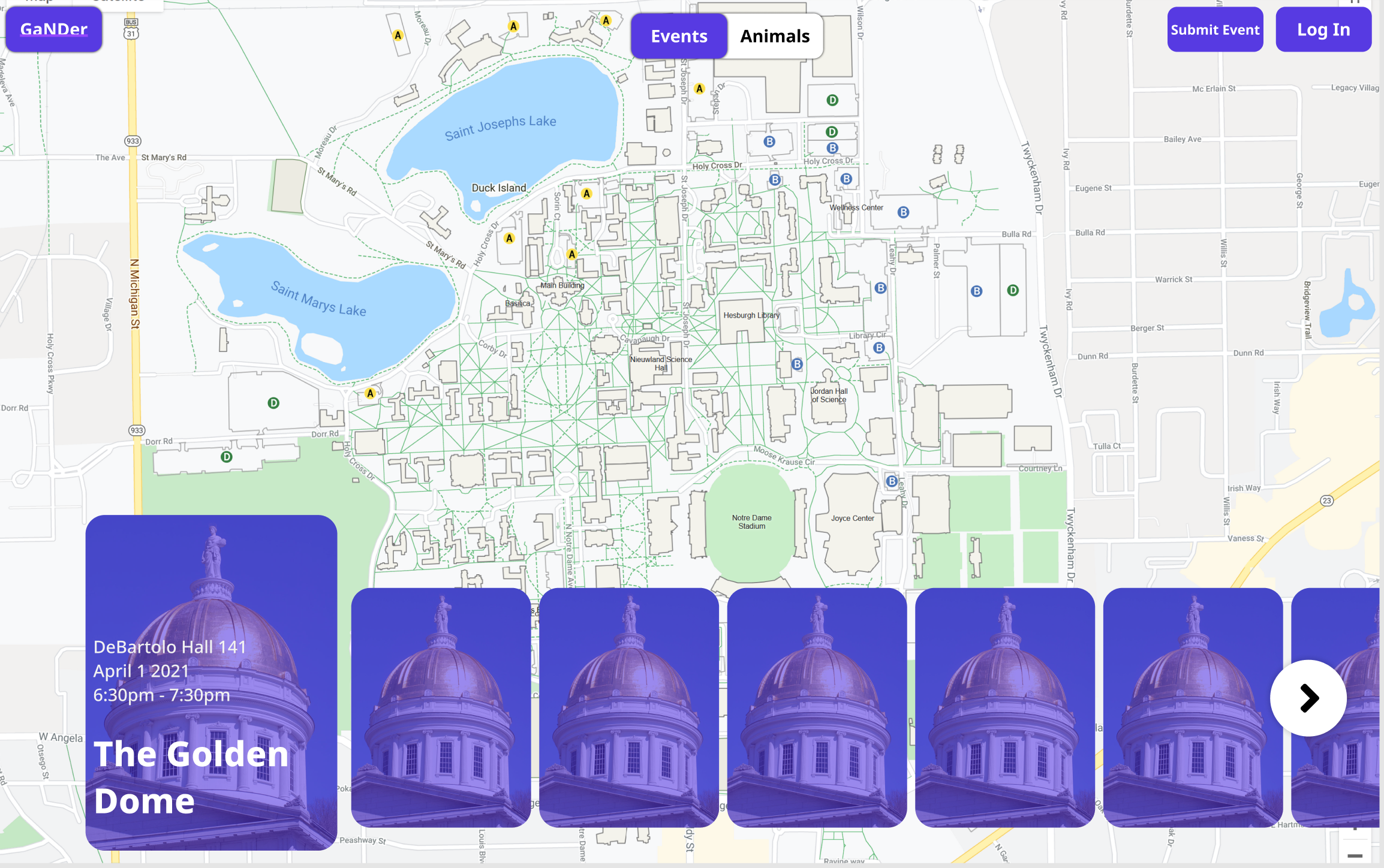Notre Dame Event Tracker
A database concepts project for finding events on campus
Problem
This project was conducted for a course titled Database Concepts. As the name implies, it was dedicated to learning about the fundamentals of databases, both the theory and the practical application, and to apply those skills in one final semester-long project.
Our group's project focused on the topic of event tracking on our college's campus. There is an official directory of events ocurring on campus, but the display of this information is often not convenient for students, and there's no way to view events on a map, or simply look at your phone and see what's happening nearby. We were inpsired by many maps applications like Google Maps or the map feature within Snapchat, which displays locations, people, or events on a map for you to discover. Our goal was to transform the information within the Notre Dame events directory and make it something fun and easily accessible for anyone.
The project requirements were very open ended. The requirements were that we were to develop an application with both a frontend and backend, which utilized a database, and allowed features like adding records, deleting records, editing them, and so forth. The frontend was to be publicly accessible or easily downloadable.
Approach
In our research, we discovered that the events directory for our college actually uses a publicly available API provided by the university. However, we wanted to maintain our own listing of events, meaning we had to download the listing of events from the API, transform them into data that fit our database schema, then ingest them into our own database. In particular, we needed to sanitize much of the data because things like event descriptions contained embedded HTML, and images used relative URLs rather than absolute.
Of course, this project contained the classic backend/frontend structure, so we also needed to decide on a stack to build this project. We selected MySQL as the database since it was a project requirement to run on a provided machine with that database installed. The backend we decided would be Python, since it was the most familiar to those delegated to making the backend. We had decided on the CherryPy server framework in order to create API endpoints that could be accessed by our frontend. In order to interact with our database, we used the officially provied driver by Oracle. In particular though, we needed to be careful about querying our database in order to avoid SQL-injection attacks.
The frontend, we decided, would be a pure web interface. I mostly led on creating that frontend. I had some experience writing websites in the past and interacting with API endpoints, but not at the scale that would be required for this project. However, this would be a wonderful opportunity to learn.
Solution
Though we had delegated frontend and backend work to separate teams, we still had to work together not only to decide things like the schema, but also to standardize API endpoints. We ran into many issues with data-ingestion that we did not foresee, such as the embedded HTML, which required using the BeautifulSoup library to strip HTML tags out of the ingested data. We also dealt with memory leaks on the server's end, causing crashes that were very difficult to diagnose.
However, easily the most complicated aspect of this project was the frontend, and doubly complicated by the fact none of our project members had prior web development experience. The frontend was written in JavaScript without any frameworks, and we utilized the official Google Maps library in order to display a map with markers. The website was quite difficult to maintain. Much of our code was littered with event listeners everywhere, and there was quite a bit of mixing UI logic, business logic, styling, and more. I think more than anything, this project opened my eyes as to why the world of frameworks exists today and why they are used. Given that this application was a single-page, it felt extremely cumbersome to manage so much state in this way by creating nodes, updating their innerHTML atrributes, and adding them to the DOM.
I think I would have done quite a bit differently if I could do this project again with the skills I have now. This type of application is exactly suited to something like React or Next.js by offering a SPA experience. Having components would have suited this project perfectly. In particular, Next.js would have worked wonderfully because it also allows you to create API endpoints that can be acessed by your web application. It would have meant we were all working with a single codebase and in a single language, meaning our productivity would have been much greater.
For our database, I believe a better fit for this project was to use an ORM in order to avoid writing raw SQL queries within our backend code. In particular something like Prisma would have been a fantastic fit for this project, since it includes a MySQL database connector, and it generates a client according to your schema that is fully typed using TypeScript, offering very powerful autocomplete in supported code editors. The worry of SQL-injection of vulnerabilities would be completely eliminated.
However, I am extremely proud of what we were able to accomplish knowing so little about web development. The final project was quite sophisticated, displaying events in a horizontal list with animations as you scrolled through each event. There was much attention paid to the UI interface, with wireframes being made in Figma complete with animations and gestures. The website was also optimized for mobile as well. This project in particular is what really sparked my passion for web developement and got me started on this career path.
Note
This project was completed for the purposes of a course in Database Concepts, therefore the source code cannot be distributed publicly.
